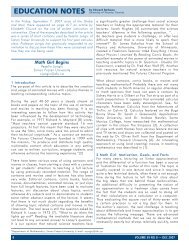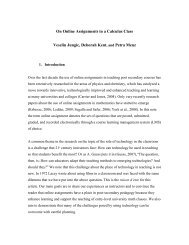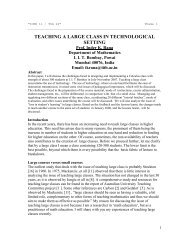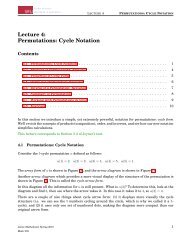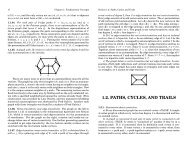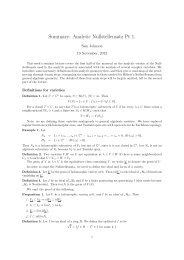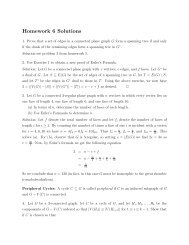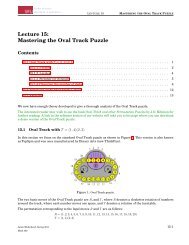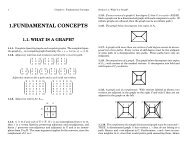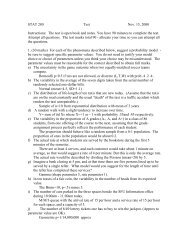AN EXPLICIT SOLUTION OF THE LIPSCHITZ EXTENSION ...
AN EXPLICIT SOLUTION OF THE LIPSCHITZ EXTENSION ...
AN EXPLICIT SOLUTION OF THE LIPSCHITZ EXTENSION ...
You also want an ePaper? Increase the reach of your titles
YUMPU automatically turns print PDFs into web optimized ePapers that Google loves.
<strong>AN</strong> <strong>EXPLICIT</strong> <strong>SOLUTION</strong> <strong>OF</strong> <strong>THE</strong> <strong>LIPSCHITZ</strong> <strong>EXTENSION</strong><br />
PROBLEM<br />
ADAM M. OBERM<strong>AN</strong><br />
Abstract. Building Lipschitz extensions of functions is a problem of classical<br />
analysis. Extensions are not unique: the classical results of Whitney and Mc-<br />
Shane provide two explicit examples. In certain cases there exists an optimal<br />
extension, which is the solution of an elliptic partial differential equation, the<br />
infinity Laplace equation. In this work, we find an explicit formula for a suboptimal<br />
extension, which is an improvement over the Whitney and McShane<br />
extensions: it can improve the local Lipschitz constant. The formula is found<br />
by solving a convex optimization problem for the minimizing extensions at each<br />
point. This work extends a previous solution for domains consisting of a finite<br />
number of points, which has been used to build convergent numerical schemes<br />
for the infinity Laplace equation, and in Image Inpainting applications.<br />
1. Introduction<br />
Building Lipschitz extensions of functions is a problem of classical analysis. For<br />
functions mapping into the reals, many minimizing extensions exist, and it is desirable<br />
to have an optimal one. The optimal extension, at least for Dirichlet data on a<br />
domain, is given by the solution of a degenerate elliptic Partial Differential Equation<br />
(PDE), the Infinity Laplacian, first studied by Aronsson [Aro67]. See [ACJ04] for<br />
a general discussion. This extension is optimal in the sense that it is an Absolutely<br />
Minimizing Lipschitz Extension (AMLE): repeated application of the extension<br />
operator on subdomains does not improve the Lipschitz constant there. AMLEs<br />
can be built in the more general setting of metric spaces, provided these are path<br />
spaces [Juu02].<br />
The optimal Lipschitz extension problem appears naturally in modern applications.<br />
The Lipschitz constant of a mapping between measure spaces gives a<br />
measure of the distortion of the mapping [LN05, MST06]. Applications include<br />
Image Processing [CMS98] and Brain Mapping [MST06]. The problem has also<br />
been the subject of a interesting connection between differential games and elliptic<br />
PDEs [PSSW06].<br />
A key step in the numerical construction of the AMLE [Obe05] is to build the<br />
optimal extension to one additional point, given function values on a finite set of<br />
points. This method was adapted to build optimal mappings in [MST06]; in this<br />
case the target space for the application is a two dimensional (cortical) surface,<br />
rather than the reals. We also mention related work [LGA98, LGA96, LG04].<br />
For mappings into spaces more general that the reals, a classical result in this<br />
direction is Kirszbraun’s theorem [Kir34] which applies to Lipschitz maps maps<br />
Date: October 22, 2007.<br />
2000 Mathematics Subject Classification. 46A22, 46T20, 58E30, 65D05.<br />
Key words and phrases. Lipschitz Extension, Absolute Minimizers, infinity Laplacian.<br />
1
2 ADAM M. OBERM<strong>AN</strong><br />
from R n to R m . As explained in [LS97, pg. 2] a key step in building more general<br />
extensions of this type is to start with a mapping defined on a finite number of<br />
points and build an extension to one additional point.<br />
On the other hand, for maps with codomain a general metric space (for example<br />
L 1 ), minimizing Lipschitz extensions which do not increase the Lipschitz constant<br />
may not always exist. In this case, the question is to study the distortion: the<br />
minimal amount that the Lipschitz constant increases [MN06, LN05].<br />
1.1. Contribution of this work. The result which we present here lies in a very<br />
different direction than the works mentioned above. While those works prove the<br />
existence of extensions in a general setting, the goal here is to build an explicit<br />
extension.<br />
Let (X, d) be an arbitrary metric space, and let C be a compact subset of X. For<br />
a given function g : C → R, we build a Lipschitz extension to X. The extension is<br />
sub-optimal (i.e. not an AMLE), but its advantage over the Whitney and McShane<br />
extensions is that it can improve the local Lipschitz constant. Also, it satisfies a<br />
maximum principle.<br />
The construction is accomplished as follows. The extension problem from a<br />
compact set to one additional point is expressed as a convex optimization problem.<br />
An equivalent optimization problem is found which has a saddle point, and can be<br />
solved explicitly. The solution to the problem at any given point can then be used<br />
to define the extension function at all points of the domain directly. The result is<br />
a Lipschitz extension function.<br />
The construction is based on [Obe05], which built the extension to one additional<br />
point, given a function defined on a finite number of points. Repeated application<br />
of the extension function locally will result in the AMLE [Obe05].<br />
As mentioned above, a key step in the argument for proving the existence of<br />
extensions in a more general setting is extending to one more point. The same<br />
technique is also needed for construction extensions for applications. In the future,<br />
we hope to investigate to whether the construction can be generalized to other<br />
target spaces.<br />
1.2. Whitney and McShane solutions of the Lipschitz extension problem.<br />
Given the function g : C ⊂ X → R, the Lipschitz constant K is the least constant<br />
for which<br />
|g(x) − g(y)|<br />
≤ K for all x, y ∈ C,<br />
d(x, y)<br />
holds. The Lipschitz extension problem is to build a Lipschitz continuous extension<br />
of g with the smallest possible Lipschitz constant.<br />
There are multiple solutions to the Lipschitz extension problem. The Whitney<br />
[Whi34] and McShane [McS34] extensions,<br />
ū(x) = inf (g(y) + Kd(x, y)),<br />
y∈C<br />
u(x) = sup(g(y) − Kd(x, y)),<br />
see Figure 1, are both solutions. In fact they are the maximal and minimal, extensions,<br />
respectively.<br />
1.3. Examples. We begin by giving some examples of the extension, using notations<br />
at definitions which follow.<br />
y∈C
<strong>LIPSCHITZ</strong> <strong>EXTENSION</strong> 3<br />
3<br />
3<br />
2<br />
2<br />
1<br />
1<br />
0<br />
0<br />
!1<br />
!1<br />
!2<br />
!2<br />
!3<br />
!2 0 2<br />
!3<br />
!2 0 2<br />
1<br />
0.5<br />
0<br />
−0.5<br />
−1<br />
−10 −5 0 5 10<br />
Figure 1. (a) The Whitney and (b) McShane extensions (solid<br />
lines) for data consisting of three points (open circles), along with<br />
the cones of opening K (dashed lines). (c) The extension u C (x)<br />
for data given at two points, and cones at x with opening K C (x).<br />
Example 1. Consider C ≡ {−1, +1} ⊂ R with g(−1) = −1, g(+1) = +1. Refer to<br />
Figure 1. The AMLE is not unique in this setting, and the McShane or Whitney<br />
extensions do not improve the local Lipschitz constant. In contrast, the extension<br />
defined herein is given by<br />
{<br />
x for |x| ≤ 1<br />
u C (x) =<br />
1<br />
x<br />
for |x| ≥ 1.<br />
and it improves the local Lipschitz constant.<br />
Example 2 (Recovery of smooth solutions of the eikonal equation). Let v be a<br />
smooth solution of the eikonal equation |Dv| = c in the convex set Ω ⊂ R n , with<br />
v = g on ∂Ω. Such functions are solutions of the infinity Laplace equation [ACJ04].<br />
We claim that u C (x) = v(x). By the the method of characteristics, v is linear on<br />
the line x(t) = x 0 + t∇v(x 0 ). Now let x 0 ∈ Ω. We claim that the arg max in (2.5)<br />
occurs at the points of intersection of the line x(t) = x 0 + t∇u C (x 0 ) with ∂Ω. To<br />
see this, compute for w, z ∈ ∂Ω,<br />
D w z g(x) =<br />
|g(w) − g(z)|<br />
d(w, z)<br />
d(w, z)<br />
d(w, x) + d(z, x) ≤ c d(w, z)<br />
d(w, x) + d(z, x) .
4 ADAM M. OBERM<strong>AN</strong><br />
The upper bound is obtained when w, z are the endpoints of the line. For such<br />
points, (2.6) is the linear interpolant, so the claim is established.<br />
2. Definition of the Lipschitz extension<br />
We define an extension by solving a convex optimization problem at an arbitrary<br />
point x ∉ C. The extension is defined at each point x independently, taking into<br />
consideration only the values of the function g(x) on C. Collectively, the solutions<br />
of each of the problems define an extension function u C (x).<br />
2.1. An optimization problem at each point. The problem of building an<br />
extension to the function g(x) defined on the set C at a given point x ∉ C involves<br />
the unknown value t = u C (x) and the ratio |g(y)−t|<br />
d(y,x)<br />
, which is the slope of the line<br />
from (x, t) to (y, g(y)). The goal will be to minimize<br />
J(t; x) ≡ max<br />
y∈C<br />
|g(y) − t|<br />
d(y, x) ,<br />
the maximum of these slopes, over the values t. The function J is convex, since it<br />
is a supremum of convex functions. Thus we are led to consider, for x ∈ X \ C, the<br />
problem<br />
(2.1) min<br />
t<br />
J(t; x)<br />
whose value and minimizer will be used to define the extension function.<br />
Definition 1. Let g : C ⊂ X → R be a Lipschitz continuous function on the<br />
compact set C. Define<br />
⎧<br />
⎪⎨<br />
|g(y) − g(x)|<br />
sup y∈C , for x ∈ C<br />
(2.2) K C (x) =<br />
d(x, y)<br />
⎪⎩<br />
min t J(t, y; x) for x ∈ X \ C,<br />
and<br />
(2.3) u C (x) =<br />
{<br />
g(x),<br />
for x ∈ C<br />
arg min t J(t, y; x) for x ∈ X \ C.<br />
We establish below that u C (x) is well-defined.<br />
We begin by finding an explicit representation for u C (x). To that end, define<br />
Dz w |g(w) − g(z)|<br />
g(x) ≡<br />
d(w, x) + d(z, x) .<br />
Theorem 1. Let g : C ⊂ X → R be a Lipschitz continuous function on the compact<br />
set C. Then for x ∉ C,<br />
(2.4) K C (x) = max<br />
(w,z)∈C×C Dw z g(x)<br />
and for any pair<br />
(2.5) (x + , x − ) ∈ arg max<br />
(w,z)∈C×C Dw z g(x)<br />
(2.6) u C (x) = d(x− , x)g(x + ) + d(x + , x)g(x − )<br />
d(x − , x) + d(x + .<br />
, x)<br />
So u C (x) is the linear interpolant of the values of g at x + and x − , weighted by<br />
the distances from x to these points.
<strong>LIPSCHITZ</strong> <strong>EXTENSION</strong> 5<br />
2.2. A saddle point proof of Theorem 1. In order to solve (2.1), we relax it,<br />
in the following way.<br />
Consider for x ∈ X \ C fixed, the function F : R × C × C → R given by<br />
( )<br />
|g(y) − t| |g(z) − t|<br />
(2.7) F (t, y, z) ≡ max<br />
,<br />
d(y, x) d(z, x)<br />
along with<br />
and the problem<br />
¯J(t) ≡<br />
(2.8) min<br />
t<br />
max F (t, y, z)<br />
y,z∈C×C<br />
¯J(t).<br />
The solution of the relaxed problem (2.8) clearly has the same value as that of the<br />
original problem (2.1), but it has a saddle point.<br />
Proof of Theorem 1. Since x is fixed, we drop the x-dependence in the notation for<br />
the duration of the proof. The resulting notation should be self-explanatory.<br />
We first interchange the minimum and the maximum in (2.8) and solve the<br />
problem<br />
max F (t, y, z)<br />
min<br />
(y,z)∈C×C t<br />
For fixed (y, z), the solution of min t F (t, y, z) is given by equating each of the two<br />
terms in the maximum (2.7), and occurs when t ∗ = t ∗ (y, z)<br />
(2.9) t ∗ (y, z) =<br />
with<br />
(2.10) F (t ∗ (y, z), y, z) =<br />
d(y)g(z) + d(z)g(y)<br />
d(y) + d(z)<br />
|g(z) − g(y)|<br />
d(y) + d(z)<br />
Assuming g(z) ≥ g(y), plugging (2.9) into (2.10) gives<br />
(2.11) F (t ∗ (y, z), y, z) =<br />
g(z) − t∗<br />
d(z)<br />
= t∗ − g(y)<br />
,<br />
d(y)<br />
as can be verified by simple arithmetic.<br />
Take<br />
(2.12) (y ∗ , z ∗ ) ∈ arg max F |g(z) − g(y)|<br />
(y,z)∈C×C (t∗ (y, z), y, z) =<br />
d(y) + d(z)<br />
then we claim that (t ∗ (y ∗ , z ∗ ), y ∗ , z ∗ ) is a saddle point for F , i.e.<br />
(2.13) F (t ∗ , y, z) ≤ F (t ∗ , y ∗ , z ∗ ) ≤ F (t, y ∗ , z ∗ ), for all t ∈ R, y, z ∈ C<br />
The second inequality in (2.13) follows immediately since t ∗ is the minimizer. So<br />
we only need to prove the first inequality, F (t ∗ , y, z) ≤ F (t ∗ , y ∗ , z ∗ ).<br />
So assume F (t ∗ , y, z) > F (t ∗ , y ∗ , z ∗ ) for some y, z. Without loss of generality,<br />
we can assume that the maximum in F (t ∗ , y, z) occurs with the term involving y.<br />
First assume that F (t ∗ , y, z) = (t ∗ − g(y))/d(y), the other case will follow using a<br />
similar argument. So rewriting our assumption, we have<br />
t ∗ − g(y)<br />
d(y)<br />
><br />
g(z) − t∗<br />
d(z ∗ )
6 ADAM M. OBERM<strong>AN</strong><br />
F(t*(y, z*),y,z*)<br />
F(t*(y*, z*),y*,z*)<br />
g(y) g(y*) t*(y*, z*)<br />
g(z*)<br />
t*(y, z*)<br />
Figure 2. Proof of optimality of t ∗<br />
where we have used (2.11). Solve for t ∗ = t ∗ (y ∗ , z ∗ ) to get<br />
(2.14) t ∗ > d(z∗ )g(y) + d(y)g(z ∗ )<br />
d(z ∗ ) + d(y)<br />
= t ∗ (y, z ∗ )<br />
where we have observed that the right hand side of this last equations corresponds<br />
to the optimal t ∗ (y, z ∗ ) as in (2.9). Plugging that value into (2.10) and then using<br />
(2.11) we get<br />
F (t ∗ (y, z ∗ ), y, z ∗ ) = |g(z∗ ) − g(y)|<br />
d(y) + d(z ∗ ) = g(z∗ ) − t ∗ (y, z ∗ )<br />
d(z ∗ )<br />
but now the inequality in (2.14) gives<br />
|g(z ∗ ) − g(y)|<br />
d(y) + d(z ∗ ) = g(z∗ ) − t ∗ (y, z ∗ )<br />
d(z ∗ )<br />
> g(z∗ ) − t ∗ (y ∗ , z ∗ )<br />
d(z ∗ = |g(z∗ ) − g(y ∗ )|<br />
) d(y ∗ ) + d(z ∗ )<br />
which is a contradiction to (2.12). So we have established (2.13).<br />
Remark 1. In the preceding argument, we showed directly that the saddle point<br />
gives a solution of the original problem (2.1), so we were justified in interchanging<br />
the minimum and the maximum in (2.8).<br />
Standard arguments of convex analysis [Ber03, pp 131–132] ensure that the existence<br />
of the saddle point (2.13) implies<br />
min<br />
t<br />
max<br />
y,z∈C×C<br />
F (t, y, z) = max<br />
min<br />
y,z∈C×C t<br />
F (t, y, z).<br />
2.3. Properties of the extension function. We now establish some basic properties<br />
of the extension function.<br />
Theorem 2. Let C, g(x), u C (x) and K C (x) be as in Definition 1. Then<br />
(i) u C (x) is well-defined.<br />
(ii) u C (x) is a continuous extension of g(x).<br />
(iii) (The maximum principle.)<br />
min g(x) ≤ u C(y) ≤ max g(x) for all y ∈ X.<br />
x∈C x∈C<br />
□
<strong>LIPSCHITZ</strong> <strong>EXTENSION</strong> 7<br />
(iv) 0 ≤ K C (x) ≤ Lip(g) for x ∈ X \ C.<br />
(v) u C (x) is Lipschitz continuous, with constant bounded by Lip(g). More precisely,<br />
(2.15)<br />
|u C (x 1 ) − u C (x 2 )|<br />
d(x 1 , x 2 )<br />
≤ min(K C (x 1 ), K C (x 2 )), for all x 1 , x 2 ∈ X \ C.<br />
(vi) (Comparison with balanced cones which meet C.) Given y ∈ X, let c ± (x) =<br />
u C (y) ± K(x)|x − y| be the upward and downward facing cones which touch<br />
u C at y. Then<br />
c − (x) ≤ u C (x) ≤ c + (x) for all x ∈ X,<br />
with equality at x − , x + , in the first and second inequality, respectively.<br />
(vii) (Growth of K C ) Given x 1 , x 2 ∈ X \ C,<br />
(2.16) K C (x 2 )dist(x 2 , C) ≤ K C (x 1 )(d(x 1 , x 2 ) + dist(x 2 , C)).<br />
rewrite as<br />
K C (x 2 ) − K C (x 1 )<br />
d(x 1 , x 2 )<br />
In particular, when C = B R ,<br />
≤ K C(x 1 )<br />
dist(x 2 , C)<br />
(2.17) K C (x) ≤ 1 K(0), |x| = tR<br />
1 − t<br />
For later use, note from (2.2) that<br />
(2.18)<br />
|g(y) − u C (x)| ≤ K C (x)d(y, x),<br />
with equality (choosing labels appropriately), at<br />
(2.19)<br />
(2.20)<br />
Also we have,<br />
g(x + ) = u C (x) + K C (x)d(x + , x),<br />
g(x − ) = u C (x) − K C (x)d(x − , x).<br />
(2.21) K C (x) = D x+<br />
x −g(x) = d(x + , x − )<br />
d(x − , x) + d(x + , x)<br />
for all y ∈ C<br />
|g(x + ) − g(x − )|<br />
d(x + , x − .<br />
)<br />
Proof. 0. Item (iii) follows from (2.6). Item (iv) follows from (2.21).<br />
1. We need to show that (2.1) has a unique minimizer. This can be proved using<br />
Danskin’s Theorem [Ber03, pg. 245], which allows us to compute the directional<br />
derivative of the maximum as the maximum of the active directional derivatives.<br />
is non-zero, the<br />
directional derivative of the max is nonzero. Thus the minimizer is unique. However,<br />
to keep the argument self-contained, we prove uniqueness directly using the<br />
characterization (2.6).<br />
First note that g is defined on a compact set, so the argmax in (2.5) is attained<br />
Since the directional derivative of each term of the form |g(y)−t|<br />
d(y,x)<br />
by at least one pair (x + , x − ). Now suppose (x + 1 , x− 1 ) and (x+ 2 , x− 2 ) are two pairs<br />
of points for which the arg max in (2.5) is attained. We wish to show that the<br />
corresponding values u 1 , u 2 , given by (2.6) are equal. So suppose that u 1 < u 2 . Let<br />
K C (x) be as in (2.4), Then, from (2.19), (2.20)<br />
g(x + 2 ) = u 2(x) + K C (x)d(x + 2 , x),<br />
g(x − 1 ) = u 1(x) − K C (x)d(x − 1 , x).
8 ADAM M. OBERM<strong>AN</strong><br />
But then<br />
D x+ 2<br />
g(x) = g(x+ 2 ) − g(x− 1 )<br />
x − 1 d(x + 2 , x) + d(x− 1 , x) = K C(x) +<br />
u 2(x) − u 1 (x)<br />
d(x + 2 , x) + d(x− 1 , x).<br />
so we can’t have u 2 > u 1 . A similar argument establishes the reverse inequality.<br />
So we have established (i).<br />
2. Next we establish (ii). Let x 0 ∈ C, by (2.18), for x ∉ C, we have<br />
|u(x) − g(x 0 )| ≤ K C (x)d(x, x 0 ) ≤ Lip(g)d(x, x 0 )<br />
where we have used (iv). So u(x) → g(x) as C ∌ x → x 0 .<br />
3. Next we establish (v). Without loss of generality, assume K C (x 1 ) ≤ K C (x 2 ).<br />
Then apply (2.19) to get<br />
and apply (2.18) with x = x 1 and y = x + 2<br />
g(x + 2 ) = u C(x 2 ) + K C (x 2 )d(x 2 , x + 2 )<br />
to get<br />
g(x + 2 ) − u C(x 1 ) ≤ K C (x 1 )d(x + 2 , x 1)<br />
combine the two previous equations to get<br />
u C (x 2 ) − u C (x 1 ) ≤ K C (x 1 )d(x + 2 , x 1) − K C (x 2 )d(x + 2 , x 1)<br />
≤ K C (x 1 )(d(x + 2 , x 1) − d(x + 2 , x 1)) ≤ K C (x 1 )d(x 1 , x 2 )<br />
which gives (2.15) as desired. Finally, applying (iv) gives (v).<br />
4. The main assertion of item (vi) follows from (2.15). The equality conditions<br />
follow from (2.19),(2.20).<br />
u<br />
K 1<br />
K 2<br />
x 1<br />
x 2<br />
C<br />
x<br />
Figure 3. Diagram to illustrate Lipschitz continuity of K C (x)<br />
away from D.<br />
5. Next we establish (2.16), follow Figure 3. First assume u C (x 1 ) ≤ u C (x 2 ).<br />
Then using (2.19) and the assumption, we have<br />
next, use (2.18) to get<br />
K C (x 2 ) = g(x+ 2 ) − u C(x 2 )<br />
d(x + 2 , x 2)<br />
≤ g(x+ 2 ) − u C(x 1 )<br />
d(x + 2 , x 2)<br />
g(x + 2 ) − u C(x 1 ) ≤ K C (x 1 )d(x + 2 , x 1)
<strong>LIPSCHITZ</strong> <strong>EXTENSION</strong> 9<br />
and combine the previous two equations to get<br />
K C (x 2 ) ≤ K C (x 1 ) d(x+ 2 , x 1)<br />
d(x + 2 , x 2) ≤ K C(x 1 ) d(x 1, x 2 ) + d(x + 2 , x 2)<br />
d(x + 2 , x 2)<br />
≤ K C (x 1 ) d(x 1, x 2 ) + dist(x 2 , C)<br />
dist(x 2 , C)<br />
which gives (2.16) in this case.<br />
In the case u C (x 1 ) ≥ u C (x 2 ), we do something similar. Using (2.20) we have<br />
and (2.18) gives<br />
K C (x 2 ) = u C(x 2 ) − g(x − 2 )<br />
d(x − 2 , x 2)<br />
≤ u C(x 1 ) − g(x − 2 )<br />
d(x − 2 , x 2)<br />
u C (x 1 ) − g(x − 2 ) ≤ K C(x 1 )d(x − 2 , x 1)<br />
The remainder of this case follows as in the previous case.<br />
6. Finally to get (2.17), take x 2 = x, |x| = r, x 1 = 0 in (2.16) to get K(x)(R −<br />
r) ≤ K(0)R and substitute r = tR. □<br />
References<br />
[ACJ04] Gunnar Aronsson, Michael G. Crandall, and Petri Juutinen. A tour of the theory of<br />
absolutely minimizing functions. Bull. Amer. Math. Soc. (N.S.), 41(4):439–505 (electronic),<br />
2004.<br />
[Aro67] Gunnar Aronsson. Extension of functions satisfying Lipschitz conditions. Ark. Mat.,<br />
6:551–561 (1967), 1967.<br />
[Ber03] Dimitri P. Bertsekas. Convex analysis and optimization. Athena Scientific, Belmont,<br />
MA, 2003. With Angelia Nedić and Asuman E. Ozdaglar.<br />
[CMS98] Vicent Caselles, Jean-Michel Morel, and Catalina Sbert. An axiomatic approach to<br />
image interpolation. IEEE Trans. Image Process., 7(3):376–386, 1998.<br />
[Juu02] Petri Juutinen. Absolutely minimizing Lipschitz extensions on a metric space. Ann.<br />
Acad. Sci. Fenn. Math., 27(1):57–67, 2002.<br />
[Kir34] M. D. Kirszbraun. Uber die zusammenziehenden und Lipschitzchen Transformationen.<br />
Fund. Math., 22:77–108, 1934.<br />
[LG04] E. Le Gruyer. On absolutely minimizing lipschitz extensions.<br />
http://arxiv.org/abs/math/0403158v1, 2004.<br />
[LGA96] E. Le Gruyer and J. C. Archer. Stability and convergence of extension schemes to<br />
continuous functions in general metric spaces. SIAM J. Math. Anal., 27(1):274–285,<br />
1996.<br />
[LGA98] E. Le Gruyer and J. C. Archer. Harmonious extensions. SIAM J. Math. Anal.,<br />
29(1):279–292 (electronic), 1998.<br />
[LN05] James R. Lee and Assaf Naor. Extending Lipschitz functions via random metric partitions.<br />
Invent. Math., 160(1):59–95, 2005.<br />
[LS97] U. Lang and V. Schroeder. Kirszbraun’s theorem and metric spaces of bounded curvature.<br />
Geom. Funct. Anal., 7(3):535–560, 1997.<br />
[McS34] Edward James McShane. Extension of range of functions. Bull. Amer. Math. Soc.,<br />
40:837–842, 1934.<br />
[MN06] Manor Mendel and Assaf Naor. Some applications of Ball’s extension theorem. Proc.<br />
Amer. Math. Soc., 134(9):2577–2584 (electronic), 2006.<br />
[MST06] Facundo Memoli, Guillermo Sapiro, and Paul Thompson. Brain and surface warping<br />
via minimizing lipschitz extensions. IMA Preprint Series 2092, January 2006.<br />
[Obe05] Adam M. Oberman. A convergent difference scheme for the infinity Laplacian: construction<br />
of absolutely minimizing Lipschitz extensions. Math. Comp., 74(251):1217–<br />
1230 (electronic), 2005.<br />
[PSSW06] Yuval Peres, O. Schramm, S. Sheffield, and D. Wilson. Tug-of-war and the infinity<br />
Laplacian. (preprint). http://arxiv.org/PS cache/math/pdf/0605/0605002v1.pdf,<br />
2006.
10 ADAM M. OBERM<strong>AN</strong><br />
[Whi34]<br />
Hassler Whitney. Analytic extensions of differentiable functions defined in closed sets.<br />
Trans. Amer. Math. Soc., 36(1):63–89, 1934.<br />
Department of Mathematics, Simon Fraser University<br />
E-mail address: aoberman@sfu.ca



